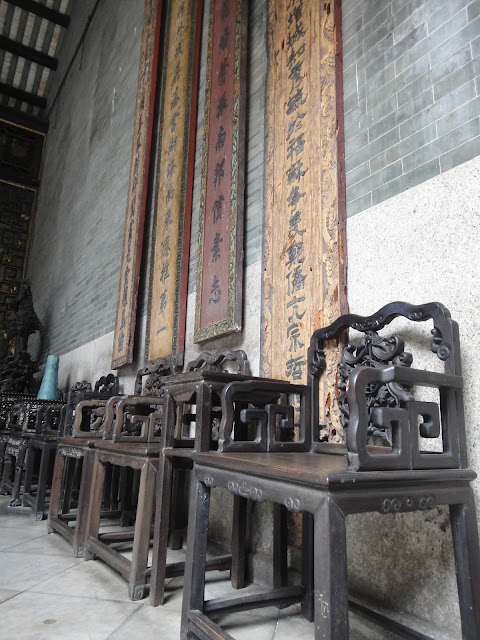" The Peranakans, also known as Babas and Nyonyas, are a community of acculturated Chinese unique to this part of the world. They are also known as the Straits Chinese, having settled along the British Straits Settlements of Penang, Melacca and Singapore. The Peranakans adopted local Malay ways and the British colonial lifestyle. These influenced its rich culture, customs, cuisine, language and lifestyle that are still evident in Penang today. " - extract from the Visitor Guide. More on Wikipedia
The Peranakan Story, YouTube
Pinang Peranakan Mansion, www.pinangperanakanmansion.com.my
 |

 |
| Beautiful old tiles of various patterns can be seen in different sections of the mansion. |
 |
| Behind the mansion, a narrow alley way at the far end on the left leads to the Ancestral Hall. |
 |
| I like these ornate but lack lustre old doors. |
 |
| The main area of the Ancestral Hall. All ceremonies will take place in front of the altar. |
My maternal grandmother was a Nyonya, not from Penang but Kedah, another Northern state in Peninsula Malaysia. Her life was far from such opulent existence. She was, I would say belongs to the middle class of her time. She was always immaculately dressed for every occasion. Blouses with intricately stitched embroideries would pair with matching sarongs and complete with the most fitting gold jewelleries.
I spent many hours of my childhood days playing with her jewelleries that she kept in a drawer when I was despatched to stay with her during those idyllic school holidays. Other than the beautiful embroideries, one of my many fascinations with the Nyonya's costumes is that the blouse come without buttons. There are tiny button holes sewn onto them, the round button which looked very much like a gold coin has a little loop on the back. The loop is then pushed through the button hole and secured with safety pin on the other side. My grandmother would decide which blouse she was going to wear before the buttons were secured onto each of the button hole. On important occasions, such as weddings, engagements . . . a more elaborate and ornate piece (which is quite similar to a brooch, often comes in three, gold with diamonds sometimes, held together by a long thin chain) will take the place of the ordinary round buttons, the choice of costume thus also varies accordingly. These are some of the little rituals I watched my grandmother did before any of her visit to an event or into town.
This is my second visit to the Peranakan Mansion. It is not a big place but there are plenty to see. Perhaps it's my childhood memories, I'll have to return, and spend more time looking at those jewelleries in glass cases in my next visit. One can easily finish touring the place in an hour or two, that's about the length of time tourists are given if they come in a tour bus. Or spend several more hours and check out the many rare and exquisite collections.










